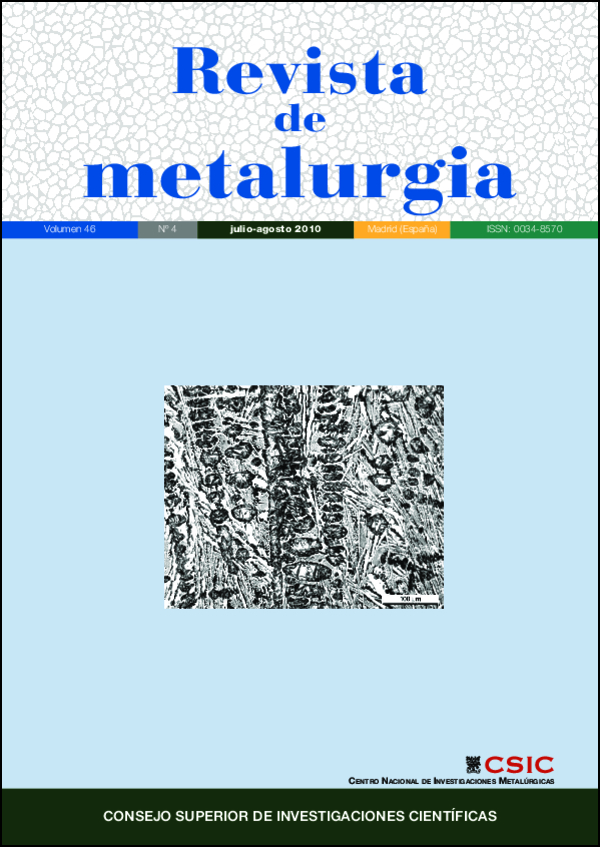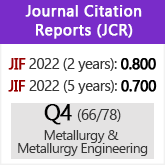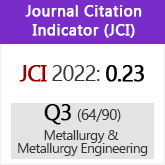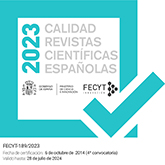Analysis of rail cooling strategies through numerical simulation with instant calculation of thermal expansion coefficient
DOI:
https://doi.org/10.3989/revmetalm.0911Keywords:
Residual stresses, Section manufacturing, Thermal expansion coefficientAbstract
This article describes a new methodology to simulate the cooling process for an asymmetrical Ri60 grooved rail, designed for city tramways, in a more realistic manner than that conducted previously by other authors for long steel sections. The approach considers the phase transformation of the steel and the forced convection cooling. The process is modelled as an uncoupled thermo-mechanical problem. First, the rail’s temperature history is obtained from a computer fluid dynamic model and subsequently introduced in the finite element model, in order to model the stresses and displacements. This second stage involves the calculation of the thermal expansion coefficient, for each element and at each iteration. The calculation is made according to the continuous cooling transformation diagram. These results lead to the extremely reliable determination of residual stresses as proved by the comparison with experimental data obtained in the industrial plant. The methodology allows for an accurate study of two types of cooling strategies for the Ri60 and the selection of the more suitable one.
Downloads
References
[1] J. Szalai, Overall sensitivity analysis if hot-rolled beam-columns, in:Metal structures: design, fabrication, economy, Millpress, Rotterdam, 2003.
[2] O. Orringer, W. Paxont, D. Gray and P. Raj, Int. J. Sci. Tech. Friction, Lubrication and Wear 191 (1996) 25-34.
[3] J. Ringsberg and T. Lindbäck, Int. J. Fatigue 25 (2003) 547-558. doi:10.1016/S0142-1123(02)00147-0
[4] J.T. Maximov, T.V. Kuzmanov, A.P. Anchev and M.D. Ichkova, J. Mater. Process. Technol. 171 (2006) 459-466. doi:10.1016/j.jmatprotec.2005.08.016
[5] S. Serajzadeh and S.M.H. Mirbagheri, Ironmaking Steelmaking 35 (2008) 115-123. doi:10.1179/030192307X233449
[6] J.B. Ordieres, A.G.Marcos, J.A. González and V.L. Rubio, Ironmaking Steelmaking 31 (2004) 43-50. doi:10.1179/030192304225012060
[7] J.B. Ordieres, V. Torre-Suárez, A.V. Pernía-Espinoza and A. González-Marcos, Rev.Metal. Madrid 44 (2008) 29-38.
[8] P.J.Webster, X.Wang and G.Mills, Proc. NATO Advanced Research Workshop on Measurement of Residual Stress using Neutron Diffraction, Oxford, Kluwer Academic Publishers, 1992, 517-524.
[9] E. Ardelean, M. Ardelean, A. Socalici and T. Heput, Rev.Metal.Madrid 43 (2007) 181-187.
[10] A. Ramírez, A. Mosqueda, V. Sauce, R. Morales, A. Ramos and G. Solorio, Rev.Metal. Madrid 42 (2006) 209-215.
[11] P. Besuner, Fracture mechanics analysis of rail with shell-initiated transverse crack, Rail Steels-Developments, Processing and Use, ASTM STP 644, 1978, pp. 303-329.
[12] O. Orringer, Crack propagation life of detail fracture in rails, Volpe National Transportation System Center, report no. DOT/FRA/ORD-88/13, October, 1988.
[13] H. Yoshida, Trans. ISIJ 24 (1984) 401-407.
[14] M. Abouaf, J.L. Chenot and J.L.Marcelin, Int. J. Num. Meth. Eng. 19 (1983) 1453-1465. doi:10.1002/nme.1620191004
[15] J.L. Marcelin, M. Abouaf and J.L. Chenot, Comp.Meth. Appl.Mech. Eng. 56 (1986) 1-16. doi:10.1016/0045-7825(86)90133-7
[16] O. Zienkiewicz, S. Valliapan and I. King, Int. J. Num. Meth. Eng 1 (1969) 75-100. doi:10.1002/nme.1620010107
[17] G. Comini, S.Del Guidice, R. Lewis and O. Zienkiewicz, Int. J. Num. Meth. Eng. 8 (1974) 613-624. doi:10.1002/nme.1620080314
[18] F.D. Fischer, E. Hinteregger and F.G. Rammerstorfer, A computational study of the residual stress distribution in thermally loaded beams of cross-section on frictional support, in: Non-linear Comp.Mechanics, State of the Art, Springer, Berlin, 1991, pp. 737-750.
[19] J. Basu, S.L. Srimani and D.S. Gupta, J. Strain Analysis Eng. Design 39 (2004) 15-24.
[20] I.I. Boyadjiev, P.F. Thomson And Y.C. Lam, J. Mat. Process. Tech. 147 (2004) 268-275. doi:10.1016/j.jmatprotec.2004.01.008
[21] Fluent® User’s guide, version 6.3, Fluent Incorporated, 2006.
[22] I.I. Boyadjiev, P.F. Thomson and Y.C. Lam, ISIJ Int. 36 (1996) 1413-1419. doi:10.2355/isijinternational.36.1413
[23] S. Kamamoto, T. Nishimori and S. Kinoshita, Mater. Sci. Technol. 1 (1985) 798-804.
[24] E. Fink and K. Pratt, DataMining In Time Series Databases M. Last, A. Kandel, and H. Bunke (Eds.), 2004, pp. 43-64,World Scientic. doi:10.1142/9789812565402_0003
[25] Abaqus Analysis User’s Manual version 6.7, 2005.
Downloads
Published
How to Cite
Issue
Section
License
Copyright (c) 2010 Consejo Superior de Investigaciones Científicas (CSIC)

This work is licensed under a Creative Commons Attribution 4.0 International License.
© CSIC. Manuscripts published in both the printed and online versions of this Journal are the property of Consejo Superior de Investigaciones Científicas, and quoting this source is a requirement for any partial or full reproduction.All contents of this electronic edition, except where otherwise noted, are distributed under a “Creative Commons Attribution 4.0 International” (CC BY 4.0) License. You may read here the basic information and the legal text of the license. The indication of the CC BY 4.0 License must be expressly stated in this way when necessary.
Self-archiving in repositories, personal webpages or similar, of any version other than the published by the Editor, is not allowed.


















